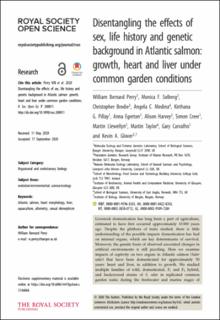| dc.description.abstract | Livestock domestication has long been a part of agriculture, estimated to have first occurred approximately 10 000 years ago. Despite the plethora of traits studied, there is little understanding of the possible impacts domestication has had on internal organs, which are key determinants of survival. Moreover, the genetic basis of observed associated changes in artificial environments is still puzzling. Here we examine impacts of captivity on two organs in Atlantic salmon (Salar salar) that have been domesticated for approximately 50 years: heart and liver, in addition to growth. We studied multiple families of wild, domesticated, F1 and F2 hybrid, and backcrossed strains of S. salar in replicated common garden tanks during the freshwater and marine stages of development. Heart and liver weight were investigated, along with heart morphology metrics examined in just the wild, domesticated and F1 hybrid strains (heart height and width). Growth was positively linked with the proportion of the domesticated strain, and recombination in F2 hybrids (and the potential disruption of co-adapted gene complexes) did not influence growth. Despite the influence of domestication on growth, we found no evidence for domestication-driven divergence in heart or liver morphology. However, sexual dimorphism was detected in heart morphology, and after controlling for body size, females exhibited significantly larger heart weight and heart width when compared with males. Wild females also had an increased heart height when compared with wild males, and this was not observed in any other strain. Females sampled in saltwater showed significantly larger heart height with rounder hearts, than saltwater males. Collectively, these results demonstrate an additive basis of growth and, despite a strong influence of domestication on growth, no clear evidence of changes in heart or liver morphology associated with domestication was identified. | en_US |
